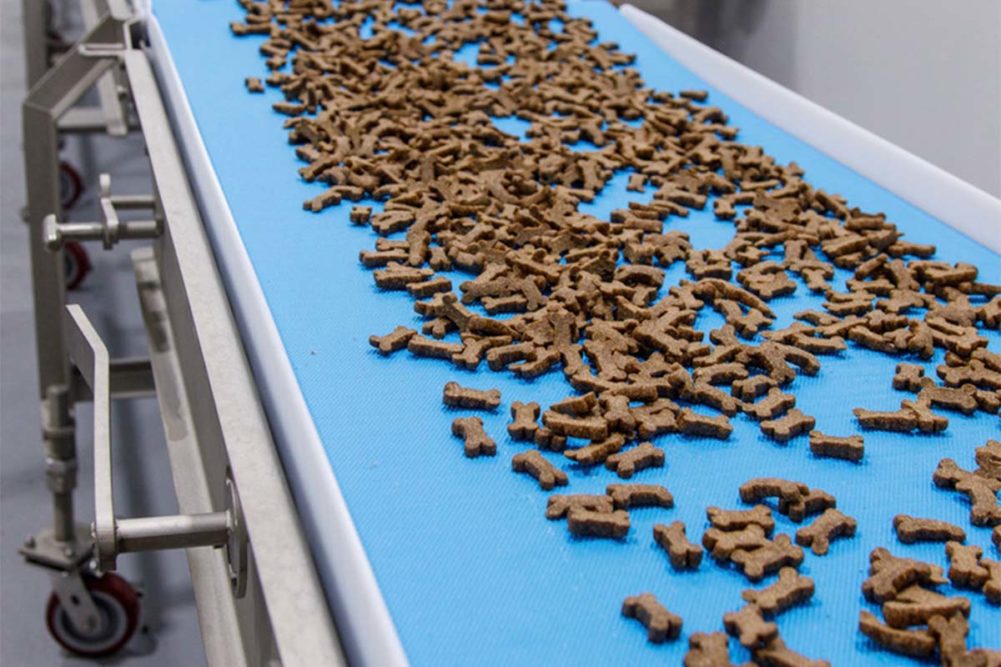MANHATTAN, KAN. — On Aug. 15, 26 professionals from various sectors of the pet food industry gathered at Kansas State University’s (KSU) International Grains Program Institute (IGP) Pet Food Workshop to dive deeper into the formulation and processing of pet foods and treats.
Led by Sajid Alavi, Ph.D., professor at the Grain Science & Industry at KSU, industry experts covered a wide gamut of topics, including trends, macro and micro ingredients, palatability, consumer research, plant design, food safety, specialty treats and more.
"The pet food workshop serves as a great stand-alone short introduction to the latest trends in pet food markets, nutrition, safety and also formulation," Alavai said. "It also is a really great supplement for those who are here at K-State for rest of the week to attend the 4-day 'Extrusion processing - technology & commercialization' course that covers in-depth extrusion hardware, ingredients and processing of pet food and other products including several hands-on lab sessions."
Industry trends
Greg Aldrich, Ph.D., research associate professor at the Grain Science & Industry at KSU, began the workshop with a dive into trends within the pet food industry.
With increasing pet populations driving the growth of the industry, Aldrich revealed that the countries leading the world’s dog population include the United States, China, Russia, Japan and the Philippines, whereas countries leading the world’s cat population include the United States, China, Russia, Brazil, and France. Despite the fact the United States is the leader in population for both dogs and cats, Europe is the leader in pet food production at 11.59 million tons of products in 2021, with the United States close behind at 10.6 million tons, and Latin America third at 7.8 million tons.
Regarding sales value, Aldrich detailed that semi-moist pet treats are gradually declining in sales as the refrigerated/frozen category gains popularity among consumers. In 2020, dry dog and cat foods led sales value at $5.35 billion and $2.44 billion, respectively, with wet dog and cat foods second at $1.88 billion and $2.39 billion, respectively.
Aldrich also discussed pet food claims, revealing that the “natural” claim has garnered significant consumer interest, though “meat first” and “high protein” remain the most popular claims. With a large desire for natural pet food products, consumers are interpreting the specific claim various ways. A majority of consumers believe “natural” to specify the lack of added chemicals, like preservatives, added hormones/antibiotics and pesticides, while a smaller amount of consumers associate the claim with the quality of ingredients, like fresh or organic.
With sustainability a hot topic throughout the industry, Aldrich detailed various formulation trends, including the use of insect- and plant-based ingredients. Aldrich also revealed that slaughtering and rendering waste could expand the potential in developing more sustainable products, particularly using blood and feathers.
Currently, research has shown that pets favor plasma, Aldrich explained, as the ingredient offers notable palatability benefits, as well as significant functional properties. However, other red blood cells are currently not being utilized.
“I don’t think anyone is collecting the rest of the poultry blood… and feathers have a huge supply,” Aldrich added. “But, we’re going to have to do some technology development to make [blood] appetizing. There’s nothing wrong with the integrity of these ingredients, it’s just that pets don’t want that much iron, so we need to separate the protein from the iron. We just need to go to the next level; there’s a lot of other red blood cells being wasted.”
Plant design and food safety
With food safety a significant priority in the pet food industry, Shaun Kibbe, project manager of corporate project services at Wenger Manufacturing, Sabetha, Kan., spoke to ways a plant can be designed with food safety top of mind. Kibbe detailed several ways food safety, specifically HACCP, can be achieved and improved through plant location, design, equipment selections and cleaning.
For design, Kibbe detailed the importance of separating raw operations from cooked or finished product operations. Curtain walls, which can be built around an extruder to separate raw materials from cooked ingredients, and zoning can help control microbes and prevent contamination of products.
With animal diseases becoming a large concern for the industry, specifically African swine fever (ASF), Kibbe advised limiting outside personnel from entering a plant. Kibbe detailed the problem Vietnam is facing regarding ASF. In the country, raw material transporters, like truck drivers, carrying the disease would often aid facility employees in transporting materials from the truck to the facility’s operations, allowing the spread of ASF.
Kibbe also advised that outside personnel should be restricted to designated areas and prevented from entering processing areas as much as possible to further reduce the potential of product contamination and the spread of diseases.
Aside from design and access restrictions, Kibbe pointed out the role specific equipment design can play in food safety. For example, pneumatic conveyors offer much easier cleaning capabilities compared to mechanical conveyors, which contain several hidden areas that can become filled with product and foster microbes and mold. Kibbe advised that equipment cleaning procedures must take into consideration the type of ingredients the equipment is processing. For example, equipment handling powders or other dry ingredients must by cleaned with air, while equipment handling fats or oils will need to be cleaned with water.


